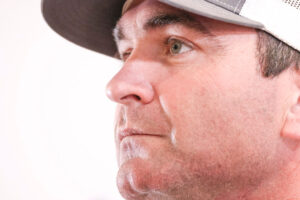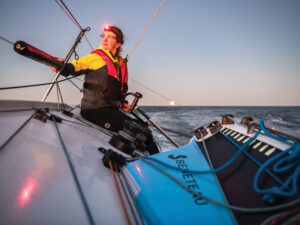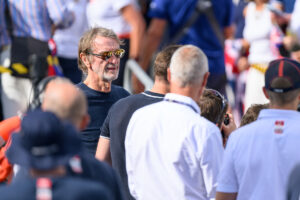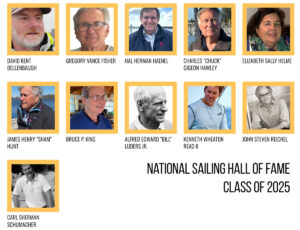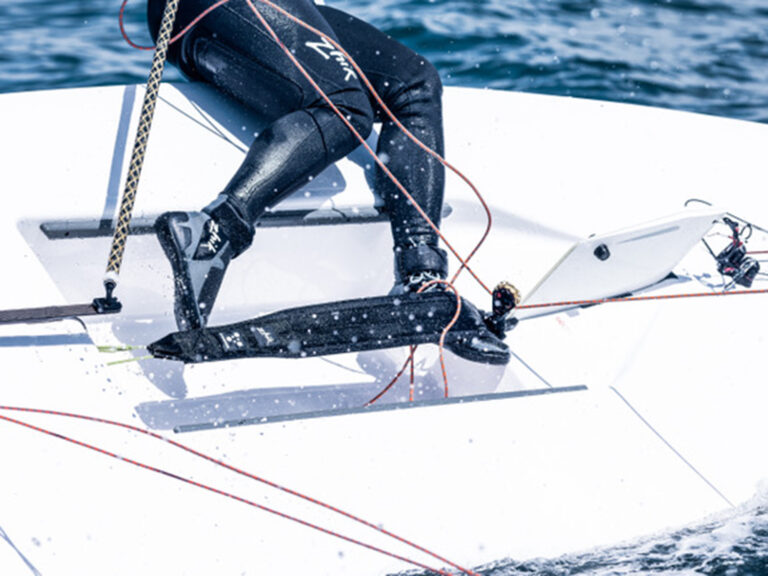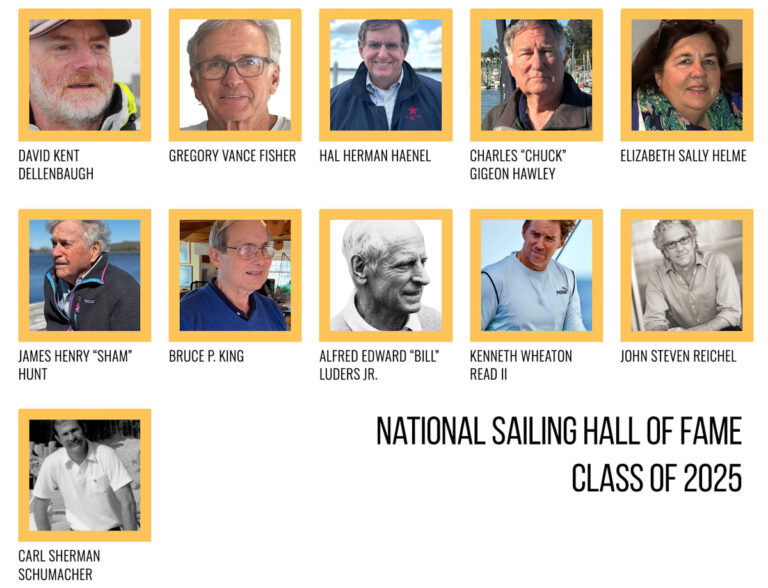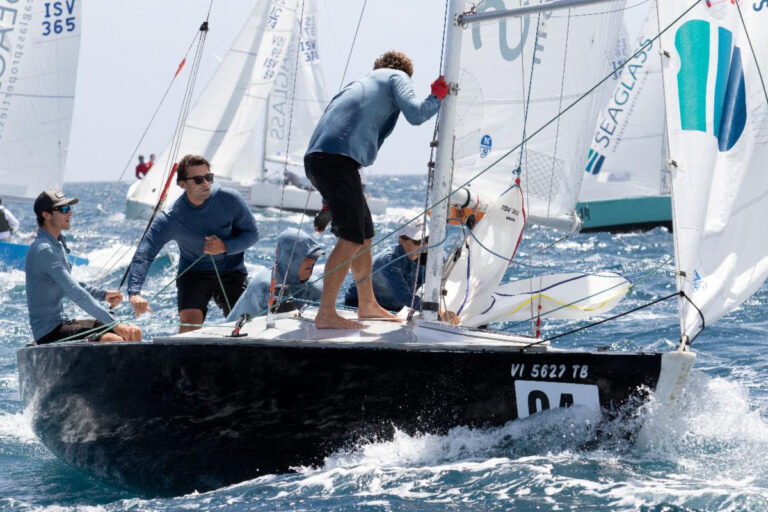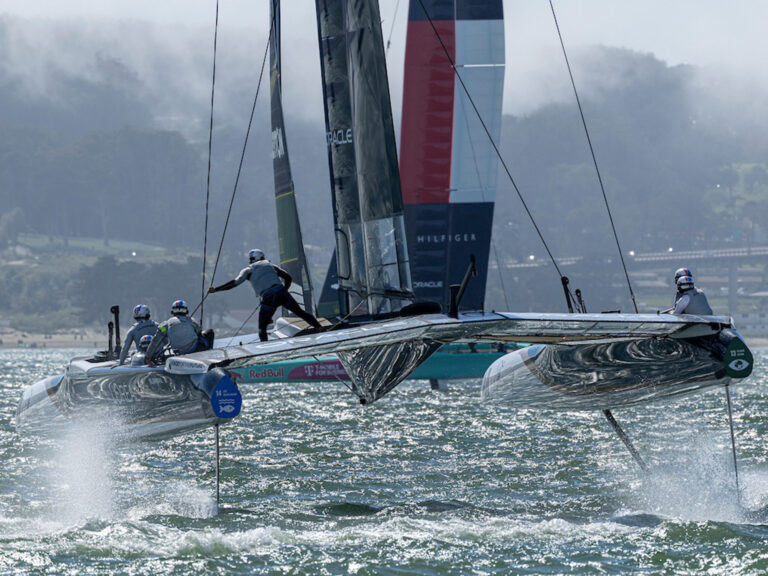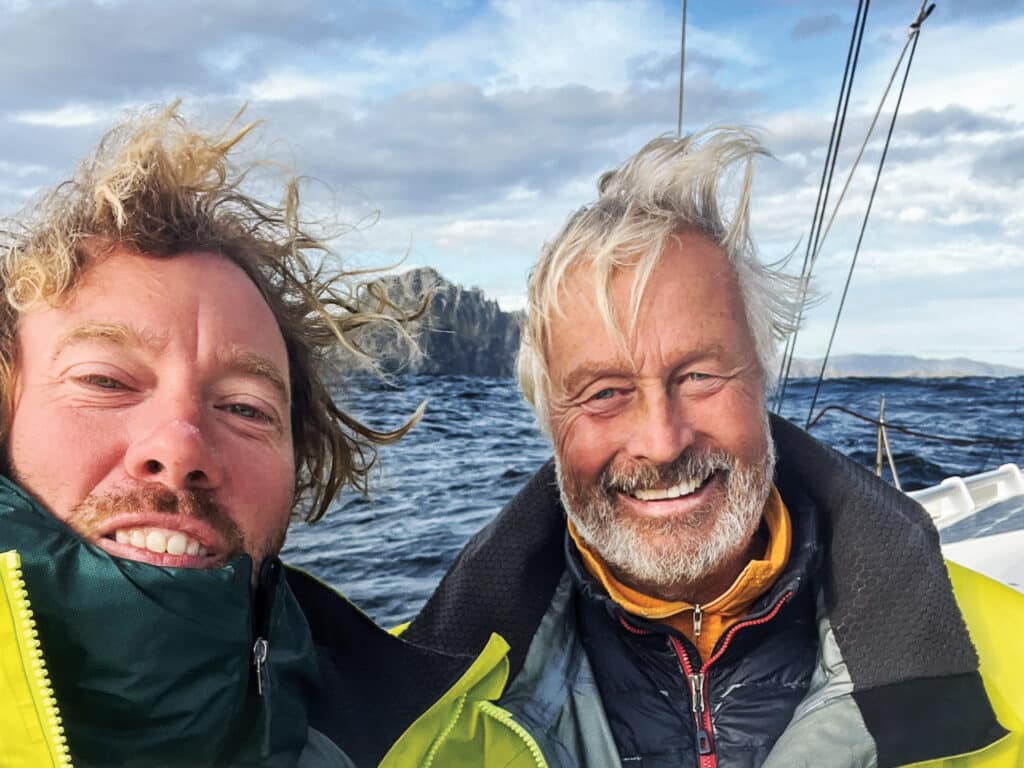
On a dark St. Patrick’s Day morning—some 15 miles from the Lorient, France, finish line for the Globe40 doublehanded round-the-world race—Joe Harris sat down at the bumpy navigation station of his extremely well-traveled Class 40 yacht, Gryphon Solo 2, and commenced to type his final blog post from a cold and rainy Biscay Bay.
“We are loping along at 7 knots of boatspeed without our foot on the accelerator for the first time in forever, as we are going to be in third place for this leg no matter what. So we are timing our arrival for daylight, and I thought this last night at sea might be a good time to digest and try to make sense of these past 10 months,” he wrote in the last of dozens of posts that chronicled the eight-leg, 35,000-nautical-mile voyage he shared with mate Roger Junet.
“Trying is a word that comes to mind. Tumultuous is another, as is turbulence, but maybe I just like words that start with a T?”
As he closed the circle on his second circumnavigation on the boat—the first had been a solo record attempt for a Class 40 in 2015-16—tenacious is another appropriate adjective. That’s because, for Harris, these last few miles were but the latest chapter in an epic nautical journey that started some five decades earlier, commencing with junior sailing, then learning the ropes on a collection of race boats from his rock-star bowman dad, to amassing his own series of racers, including an old, leaky wooden boat, a C&C 40 and an Aerodyne 38. Finally, he moved into the elite realm of shorthanded offshore sailing, first on a canting-keel Open 50 before moving into the Class 40 battles and knocking off a pair of circles around the planet.
And that’s not even counting the seven summers he spent in Alaska’s Bering Sea crewing aboard and then skippering commercial fishing boats out of Bristol Bay. How to sum up this maritime odyssey? It had certainly been a lot of things: technical, taxing, transforming, thorough, tremendous.
Harris comes from strong saltwater genes. For fun, his Dutch grandfather, Dr. Hans Rozendaal, conducted regular transatlantic voyages throughout his life, a total of six in all. His old man, Woody, was a sought-after crewman in his day, winning the Triple Crown of yacht racing—the Transatlantic Race, Cowes Week and the Fastnet—in the late 1950s aboard Richard Nye’s famous Rhodes Yawl, Carina. That was before Woody bought his own 75-foot Chesapeake Bay skipjack to tool around Long Island Sound.
Born and raised in Greenwich, Connecticut, Harris’ own path to the sea began in the junior program on Blue Jays and Lightnings at the Indian Harbor YC. In his teens, however, sailing took a back seat to other sports, particularly hockey and lacrosse, the latter he played four varsity seasons at Brown University. A road trip to Alaska his junior year, which started a string of seven lucrative summers in his own version of The Deadliest Catch, rekindled his passion for the water, especially the gnarly offshore stuff.
A year at The Landing School in Maine gave him the woodworking and carpentry skills he parlayed into winter boatbuilding gigs at Shannon Yachts in Rhode Island and Ted Hood’s Little Harbor yard in Marblehead, Massachusetts. Somewhere in there, he also built and sold a home on Block Island. It was all good fun, and he was making decent coin, but it wasn’t the career path of your typical Ivy League grad.
Approaching his late 20s, Woody hit him with the age-old, fork-in-the-road question that’s been posed down through countless generations of fathers and sons: What the hell are you doing with your life? When Woody offered to pony up half the tuition to business school, Harris matriculated to Babson University for his MBA, which led to not only a long, lush career in real estate finance and development, but also provided plenty of the cold, hard cash that was its reward. That gave him the means, almost immediately, to invest in sailboats.
The first was a little woody (no pun intended) named Corus, which he soon began calling Pourus in recognition of the steady ingress of water through its seams. Next up was Shiva, so named for a Hindu god, the C&C 40 aboard which he started his skippering career with coastal races, eventually becoming the platform for his initial forays into doublehanded racing with, appropriately enough, Woody as crew. After that came Gryphon, a 38-foot sportboat designed by the late Rodger Martin, aboard which he continued racing two up and also started competing in solo events like the Bermuda One-Two.
For a sailor with ever-growing long-distance ambitions, it had been a steady, ascending trajectory in the sport. The next step was a major one into a certified big-boy boat, a carbon-fiber, canting-keel, twin-daggerboard, water-ballasted Open 50 rocket designed by French aces Finot-Conq. It was a veteran of two round-the-world solo contests, the most recent by American Brad Van Liew under the handle Tommy Hilfiger Freedom America.
The goal was a round-the-world race called the Velux 5 Oceans Challenge, organized by the famed British solo legend Robin Knox-Johnston. After originally calling his new ride Gryphon Solo, Harris slapped on a new name, Wells Fargo American Pioneer, after securing a sponsorship deal with the prominent bank with which, not coincidentally, he was conducting a ton of business—a win-win situation.
His inaugural Grand Prix event was the 2004 edition of Artemis Transat (formerly called the OSTAR), a brutal 16-day upwind slog across the North Atlantic from Plymouth, England, to Boston, in which he scored second in class. With veteran English sailor Josh Hall, Harris then knocked off an Open 50 class victory on the 21-day voyage from France to Brazil in the Transat Jacques Vabre in 2005, a trip designed to be the serious tuneup before the Velux race.
But there was a hiccup, and it was a momentous one: More or less at the last minute, the organizer pulled the plug on the Open 50 class. Harris was, quite literally, all tuned up with nowhere to go. It was time, as they say, to pivot. And the timing was fortuitous, for there was a relatively new boat and game on the shorthanded offshore racing scene: the Class 40.
Harris purchased his Marc Lombard-designed 40-footer, Gryphon Solo 2, in 2011, aiming to be on the starting line of a dedicated Class 40 round-the-world contest, the Global Ocean Race, in the fall of 2014. In preparation, he knocked off a trio of Atlantic Cup races—a dash up the Eastern Seaboard from South Carolina to Maine—winning it in early 2014. And then the unthinkable happened: the Global Ocean Race was also canceled.
“Once again, I was all dressed up with no place to go,” he says. “After all the time and money I’d put into the new boat, I couldn’t believe it was happening again. So, I said to myself, ‘I’m not getting any younger, and I’m tired of waiting for these races. I’m going to do a solo,
unassisted round-the-world record attempt.’”
It turned out a Class 40 record of 138 days was on the books already, established by Chinese sailor and explorer Guo Chuan in 2013. (Chuan was tragically lost at sea during a singlehanded transpacific record attempt in 2016.) Unfortunately, Harris’ 2015 record run unraveled in the South Atlantic on his approach to South Africa, when the converter box on his hydrogenator fried and forced him into Cape Town for repairs. After resuming the voyage, GS2 hit what Harris called a USO, unidentified submerged object, which punctured the hull and forced an unscheduled haul-out in Uruguay to make repairs. But between those stops, he made a memorable rounding of Cape Horn in a 50-knot gale. Ultimately, he closed the circle on his lonely circumnavigation in mid-2016 after a 33,000-nautical-mile spin of 152 days.
For many marathon solo sailors, if not most, it would’ve been the crowning achievement of a noteworthy sailing career. For Harris, however, there was still unfinished business to attend to, a missing check mark on his personal, proverbial bucket list: He still hadn’t raced around the planet. That is, not until the recently concluded Globe40 affair.
Organized by Sirius Events, the doublehanded Globe40 was not your typical round-the-world race. Beginning in Morocco and finishing in France, the 33,000-nautical-mile event was significantly longer than previous traditional, four-stop round-the-world races. This event rounded the great southern capes before heading north into generally lighter, upwind conditions, which extended the length and time of the legs.
The winding, eight-leg racecourse, with a decidedly French accent, included stopovers in the Cape Verde Islands; Mauritius; Auckland, New Zealand; Tahiti; Ushuaia, Argentina; Recife, Brazil; and Grenada. Crew swaps were permissible (the Canadian entry Whiskey Jack rotated through six co-skippers); an initial entry list of 15 boats was whittled down to seven starters, of which there were a quartet of finishers. The Dutch duo of Frans Budel and Ysbran Endt on Sec Hayai were the winners; Gryphon Solo 2 notched a fourth after an extremely eventful voyage of 173 days.
For crew, Harris recruited Junet, an Italian born and bred in the Alps who’d moved to Portland, Maine. “He was an excellent partner,” Harris says. “We got our onboard routines down pretty good. Having the continuity was a real benefit. Our sail changes became very slick.” That said, racing a Class 40 offshore is no picnic. “Actually, it’s very uncomfortable,” he says. “The motion of the boat is very violent. Particularly upwind, the boats just slam horribly in a seaway. They have a really flat forefoot, and they just pancake.”
The opening leg from Morocco to the Cape Verde islands was, “just fabulous,” Harris says. “First a reach and then downhill, which is when you’re loving life on a Class 40.” But the second leg, around the tip off Africa and up to the isle of Mauritius? “A nightmare,” he says. “It was supposed to be about 32 days and ended up being almost 40. You get around the Cape of Good Hope and you’ve got a foul current and you’ve got a thousand miles upwind in light air.”
A series of gates the fleet was obliged to honor, ostensibly in the interests of safety, chopped up the next legs in what in most round-the-world races are straight shots through the Southern Ocean, a section of the trip Harris had reveled in during his previous circumnavigation. So too did the side trip to Tahiti, again off the beaten track, but at least with the addition of a pleasant visit to French Polynesia.
The leg to Ushuaia ended off Cape Horn before a detour up the Beagle Channel, which was unusual but interesting. Next was a long journey to Recife, with the bulge of Brazil positioned well east in the South Atlantic, which made the ensuing leg back to Grenada somewhat of a non sequitur because it sent the racers in the opposite direction of the finish line in France.
And then there was just one last passage back across the North Atlantic. “Twenty days,” Harris says. “One low-pressure system after another, just continuously slammed, 30 knots and above most of the time. Cold and getting colder. Reduced sail, three reefs in the main. We saw a 63-knot gust, the highest of the whole race. Luckily, we were going downwind nearly the whole way, which was great. But then came the end, the finish.”
And, of course, the last thoughts on that last blog post: “As we come down the home stretch, it is a bit of a melancholy feeling to know that this adventure will soon be over. I am glad I did it for sure, but I am also glad to move on to the next challenges… I love our little GS2 space module/biosphere, where we make fresh water from salt water, produce electricity from moving through the sea and from the sun, and move across the water only through the power of the wind in our sails. I will miss it for sure, as it is a natural high and feels right just being at sea in this fine craft.”
The only thing left to say to sum up the whole crazy sprint of his sailing life, with that last circle now closed, perhaps needed just one more “T” word.
Triumphant.

